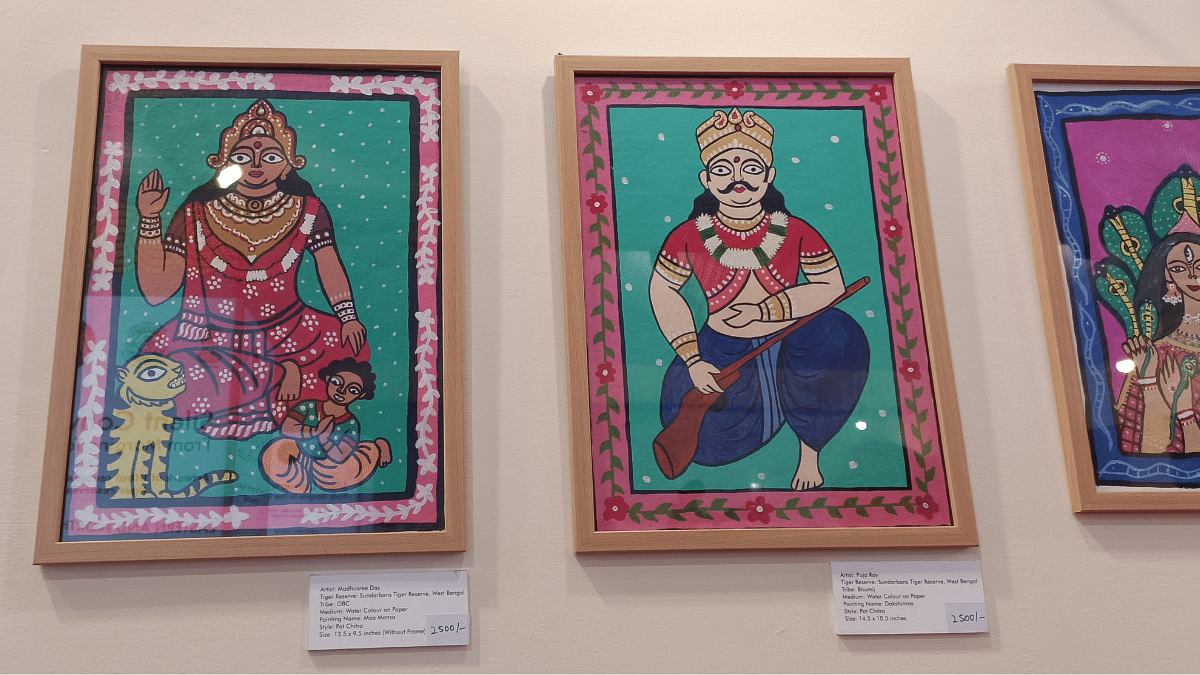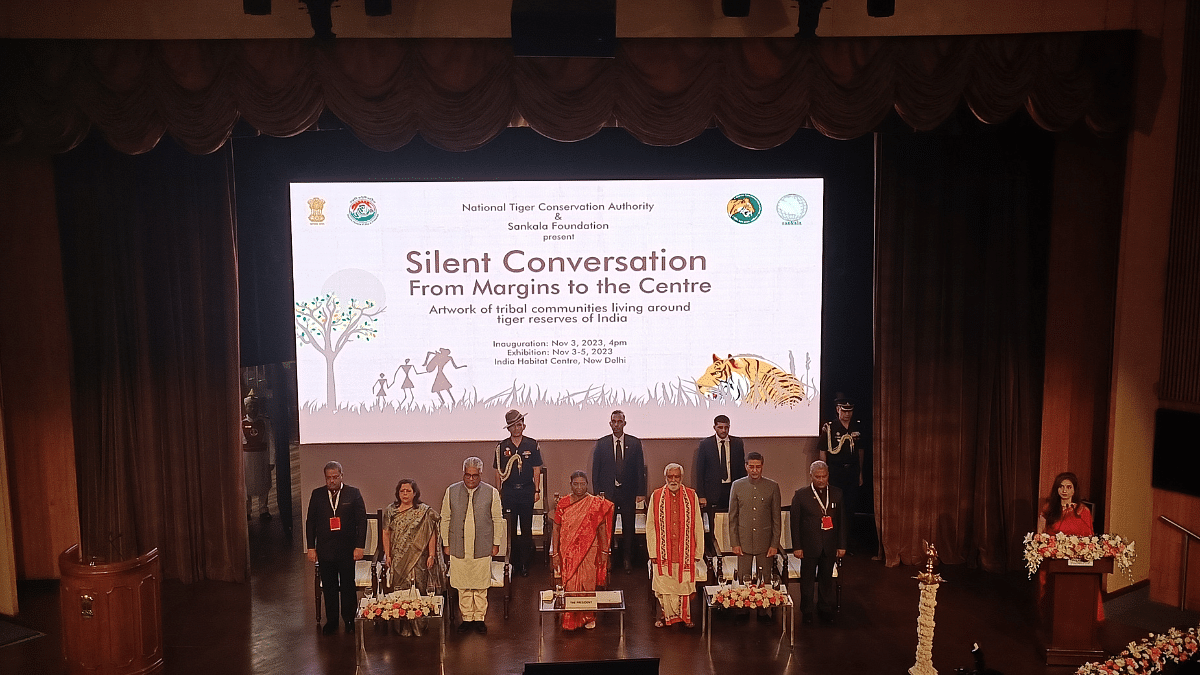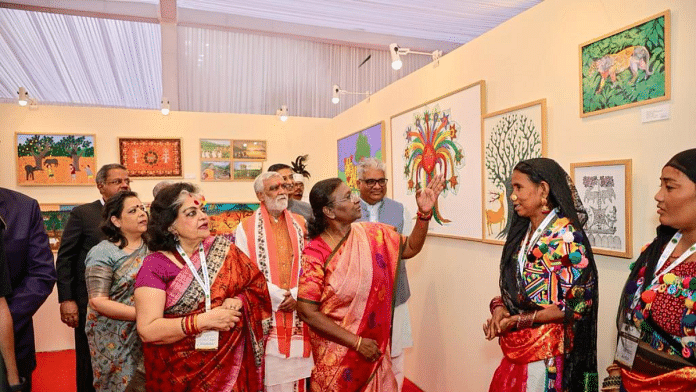New Delhi: Bono Devi is the powerful goddess of Sundarbans in West Bengal, never seen without her mighty consort — the Bengal tiger. Having grown up with the stories of the goddess in her village adjacent to the Sunderban Tiger Reserve, 32-year-old Madusree decided to portray her through her paintings at an exhibition at Delhi’s India Habitat Centre. Called ‘Silent Conversation: From Margins to the Centre’, the three-day exhibition marks the completion of 50 years of Project Tiger and was inaugurated by President Droupadi Murmu Friday.
And the occasion became a tribal art affair in elite Delhi.
Organised by the National Tiger Conservation Authority (NTCA) under the Ministry of Environment, Forest and Climate Change (MoEFCC) and the Sankala Foundation, a Delhi-based NGO, the exhibition brought 42 tribal artists from 35 tiger reserves across India to show and sell their artwork.
“These paintings show us how tribal communities do not just share a bond of livelihood but a bond of the heart with tigers,” said Leena Nandan, MoEFCC secretary, in her address.

Just the way the exhibition aimed to show the richness and diversity of tribal art, the gathering at IHC was a colourful lot — school students, academics, foreign delegates, and journalists crowded the auditorium, staring goggle-eyed at the paintings.

“India’s tiger conservation programme would have been impossible without the support of communities that live nearby,” said the President in her address, lauding NTCA’s achievements in the past 50 years. She also emphasised the importance of learning from tribal communities how to exercise prudence in dealing with the environment.
Also present at the inauguration ceremony were Bhupender Yadav and Ashwini Choubey, Union and state minister for the MoEFCC, respectively. Yadav recounted the history of Project Tiger, which was launched in 1973 under the Indira Gandhi government. Today, India boasts of more than 3,600 tigers in 53 tiger reserves.
Yadav also spoke about how Project Tiger was not just about conserving wildlife.
“We conserved the ecosystem, rivers, and biodiversity within the reserves too, which, in turn, helped conserve the livelihoods of the communities nearby.”

Also read: One woman’s mission to revive Chettinad culture. ‘Things were disappearing in front of me’
Culture, cats, communities
The IHC exhibition was set up to showcase the relationship that Indian tribal communities share with the big cats. “Paintings were the most overwhelming response, and every community had its vivid styles to showcase,” said Yamini, a research associate at the Sankala Foundation.
From Odisha’s Similipal Tiger Reserve and Assam’s Manas National Park to Madhya Pradesh’s Panna National Park, tribal artists brought the best of their artwork that reflected the peculiarities of their cultures. As visitors went around the exhibition, they met and interacted with the artists who shed light on their work and its significance. The tiger goes from being feared in one community to being worshipped and revered in another, such as Karnataka’s Soligas tribes and Kerala’s Jenu Kuruba tribe.
“When we harvest honey in our villages, we leave some on the ground as an offering for the tigers,” an artist from Kerala explained to schoolchildren at the exhibition.
The exhibition empowers the tribal artists in material terms too. The first of its kind hosted by Sankala in association with the NTCA, it allows artists to sell their work.
“All proceeds go directly into the bank accounts of the artists themselves,” explained Yamini. “The goal is to enhance their livelihoods by providing a new source of income. We are just the facilitators.”
The conversation moved from marveling at the art to discussing tribal livelihoods and contributions to conservation efforts. Yadav acknowledged the efforts of communities such as the Baigas of Madhya Pradesh, Soligas of Karnataka, and Chenchus of Odisha for “leading the way” in tiger conservation in the country. “They continue to prove that sustainable and peaceful coexistence is possible for humans and wildlife,” he said.
President Murmu, too, focused on the need to emulate Indian tribal communities’ models of conservation—“not just to save the environment, but to save humanity”.
The speakers remembered Kailash Sankhala, a conservationist who served as the first director of Project Tiger. Known as the ‘Tiger Man of India’, he received the Padma Shri in 1992 for his work in conservation.

Puja, 23, was excited to display her pattachitra paintings, especially as she was visiting Delhi for the first time. “We live on stories of our tigers – as foes, as friends, as part of our communities,” she said, showing her water-colour depiction of a tiger drinking at a lake. The inspiration is already there inside us, around us.”
(Edited by Humra Laeeq)



